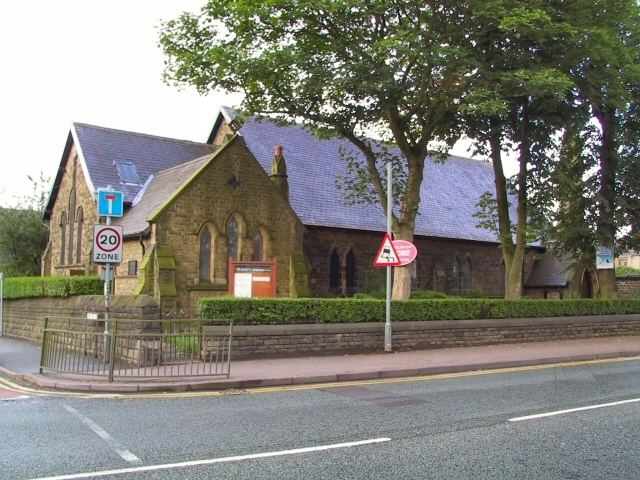Population 1,505 (2001 Census) Dialling code 01457 | OS grid reference SK006962 Sovereign state United Kingdom Local time Monday 2:02 PM | |
 | ||
Weather 11°C, Wind W at 24 km/h, 78% Humidity | ||
Hollingworth is a village in the Metropolitan Borough of Tameside, in Greater Manchester, England. It is about 12 miles (19 km) east of Manchester on the Derbyshire border near Glossop. Historically part of Cheshire, it gave its name to a family who owned much of the surrounding area from before the time of the Norman conquest.
Contents
Map of Hollingworth, UK
Toponymy
Hollingworth was recorded Holisurde before 1059 and in 1086. Its name is derived from the Old English holegn, for holly and worð an enclosure. In 1059, Hollingworth was surrounded by dense forests.
Early history
An ancient pagan religious site known as Wedneshough Green was located in Hollingworth, A grassy knoll opposite the Gunn Inn was anciently called Wedenshaw or Woden's Hawe after the pagan god Woden. The region was populated by Celts, the Pecsaetans a southern branch of the Brigantes. The group became a distinct ethnic tribe in the Mercian Kingdom of the West Angles. The tribes living in the Longdendale Valley were pagans until around 627AD when the surrounding districts started converting to Christianity.
Hollingworth was in the ancient Hundred of Hamestan before 1000 AD which is believed to be the ancient boundaries of the Pecsaetan tribesmen. After the Norman conquest in 1086, the Hundred of Hamestan was redefined and renamed the Hundred of Macclesfield.
Manor
Hollingworth was an ancient manor governed by a local lord. Members of a single family, the Hollingsworths, were lords of the manor for more than 700 years. In this part of Cheshire, local lords assumed the name of their manor as their surname. Some were granted arms by the Earl of Chester. The family's ancient arms are three holly leaves.
In 1059 when the Saxons ruled Cheshire, Hollingworth was held by a freeman who owed his rights to his senior lord; Edwin the Earl of Chester. Edwin was the chief lord of all the manors in the Hamestan Hundred. He leased the manor of Hollingworth to a freeman and his descendants for an annual rent and military service. In 1059, Hollingworth had 30 acres of productive farmland. The Saxon freeman in possession of the manor was removed sometime before 1086 by the Normans.
After the Norman conquest of England, Earl Edwin's lands were forfeited. The Domesday Book in 1086 shows that Hollingworth manor was barren and worthless. Paul Howson and William Booth wrote that 'No population is recorded for the area covered by the later forest of Macclesfield or the Lordship of Longdendale ...'. The Lordship of Longdendale was a term that came into common use around 1359, to describe a parcel of manors which includes Hollingworth. The wholesale ejectment of the Saxons from manors in Longdendale appears to have specific to those lands under the control of Hugh Lupus, Earl of Chester. He replaced the Saxon freeman on the Cheshire side of Longdendale with Normans and Saxon farmers under the control of a local Saxon chieftain called Wulfric (pronounced Uluric). On the Derbyshire side of Longdendale, which was controlled by the king, many ancient Saxon families remained in control of their lands.
The Domesday Book shows that Hollingworth was held by the Earl of Chester with no local lord in control of the manor. The Saxon chieftain Wulfric managed manors in Longdendale on behalf of the Earl of Chester. Heavily wooded and dangerous because of wolves in the forests, Hollingworth and the manors of Mottram, Matley, Tintwistle and Stayley appear to have been wilderness until 1211. By 1140 local farmers assumed the name of their manor as their surname. Sometime before 1211, a Norman knight of Saxon origins took up residence at Bucton Castle in Tintwistle. Sir William De Neville (De NovaVilla), whose ancestor had fought with William the Conqueror in 1066 and loyal to the Norman of Earl of Chester was installed as over-lord to manage the local lords in possession of Hollingworth, Wolley, Broadbottom, Hattersley, Wernet, Matley, Stayley, Mottram-in-Longdendale and Tintwistle.
In 1211, William De Neville gave his son-in-law, Thomas de Burgh or Burgo, control of all the manors in Longdendale as the supreme over-lord. Around 1222, Thomas de Burgh took the neighbouring manor of Godley from Albinus and gave it to Adam, son of Reginald de Bredbury. Witness to this deed was a 'Tomas de Holinwurthe'.
The earliest recorded Hollingworths are Tomas de Holinwurthe circa 1222, 1246; and Henry de Holenwart in 1222. The ancient manor of Hollingworth including the minor manors of Thorncliffe and Wolley was held by the de Holynworths of Hollingworth Hall by 'knight's service'. By 1359, the manor was owned by different scions of the Hollingworth family. Greater Hollingworth was owned by the senior branch living at Hollingworth Hall. Little Hollingworth was inherited by a younger brother who lived at Old Mottram Hall, he married the heiress to Matley Hall. A younger sister held a share of Thorncliffe manor, lsoa called Little Hollingwoth manor and was at Thorncliffe Hall in 1359.
The ancient family of Hollingworth migrated to London, Lincoln, Maidestone in Kent and Dale Abbey in Derbyshire. A pedigree for the family shows they descended in a continuous male line from the Lords of Hollingworth to the present day.
Hollingworth Hall is no longer standing, but the family's chapel remains.
Transport
The village is served by the A628 road (leading to the Woodhead pass to Barnsley) and the A57 road (leading to the Snake Pass to Sheffield). Going west, the A57 joins the M67 motorway a couple miles from the village. The M67 goes towards Manchester. It has severe traffic congestion.
It also has the Stagecoach Bus Service, 237 and 236, going from Glossop to Ashton-under-Lyne, every 20 minutes up until 6pm then running every hour.
Education
There are two schools in Hollingworth:
